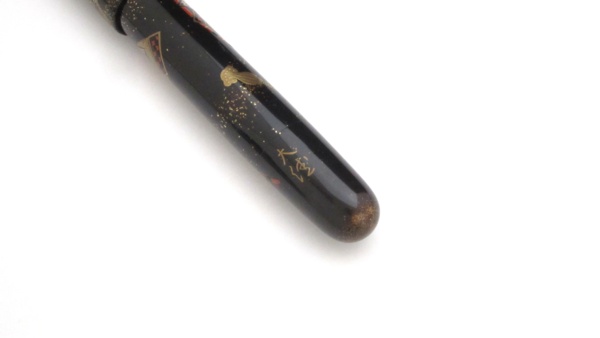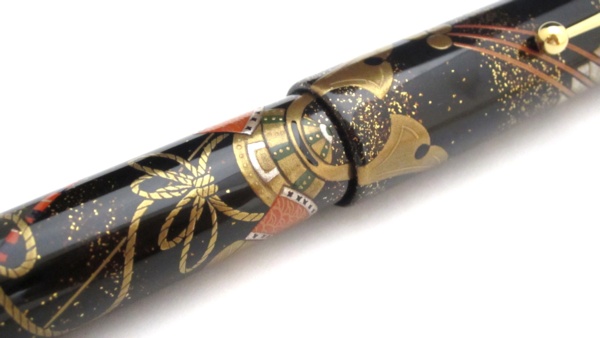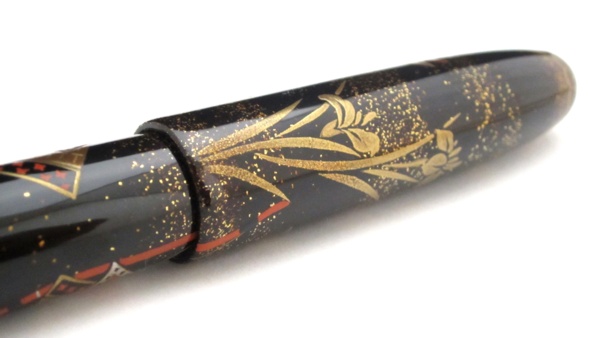AGJ Original Maki-e Fountain Pen #13 "The Boy's Festival on the 5th of May" Namiki Urushi Emperor size Sparkling Togidashi Taka Maki-e Kyoto Japan Wa
AGJ Original Maki-e Fountain Pen #13 "The Boy's Festival on the 5th of May" Namiki Urushi Emperor size Sparkling Togidashi Taka Maki-e Kyoto Japan Wa
Please contact us from here for the price.
Item Description











This Authentic Goods from Japan's Original Maki-e Fountain pen is made by famous Kyoto Maki-e Artisan "Daikai".
This pen is only one in the world. You could not find it anywhere.
Kyoto Maki-e is the best known Maki-e technique in Japan.
This is original maki-e fountain pen based on Namiki Urushi Emperor size Black.
[Description]
Name: The Boy's Festival on the 5th of May #13
( Namiki Urushi Collection Black )
Maki-e Artist: DAIKAI
Technique: Togidashi Taka Maki-e
Origin: Kyoto, Japan
Nib: 18K Gold
Nib size: Medium
Size: 20mm(Dia.) x 175mm
Shipping: FREE SHIPPING!
Others: With the pen stand
Custom engraving service on AGJ's original Maki-e fountain pens is available for those who wish.
1. The lead time: it takes 10-14 days on top (orders without this service will be usually dispatched in 3-5 days after confirming the payment).
2. The cost: US$100.00.
3. The letters of the name engraved will be engraved in gold just as the signature of the Makie artisans of Original fountain pens.
4. Please send us the sample letters which you wish to engrave on the pen (there could be a case where we are unable to engrave the letters of your choice after consulting with the Makie artisans. Letters can be in Japanese Kanji, Katakana and Hiragana but if you choose Kanji, we will use phonetic symbols).
5. Please indicate the exact position where you wish to have your name engraved (please understand that there could be a case where we may have to change the position of engraving after consulting with the Makie artisans).
*Please contact us should you have any queries regarding custom engraving service.
May 5th is called "Kodomo-no-Hi". Traditionally, it is a celebration for boys. Many families decorate a "kabuto" which is a samurai helmet or a "Gogatsu Ningyou", a samurai doll. It is believed that they protect boys' health and happiness.
We also fly "Koinobori" outside of our houses. Koinobori are big carp-shaped streamers on a long pole.
The pole is about 5-6 meters tall, so on windy days, the carps look like they are swimming in the sky. They symbolize future success because carps are said to climb waterfalls without giving up.
Technique: Togidashi-taka Maki-e (Makie)
Process:
1. The whole black area is swollen by black color Urushi evenly after the black Urushi lacquer area of the foundation is smoothed.
2. On the tops of a cap and barrel and the surface of the barrel, Gold Hirame (thin gold plates) are sprinkled. Then, paint transparent matt urushi lacquer and burnish it.
3. On the areas of the three circles of the arrow top and gold part of the Japanese helmet (Kabuto), silver powders are sprinkled.
After these areas are highly elevated, paint the mix of Bengara lacquer and Black lacquer urushi on them. They are more raised. Then, burnish and polish on them, and paint Urushi again, and sprinkle Gold powders. Coat by finishing urushi.
After the polish, golden color is gradually shining.
4. The areas of the arrow feathers and silver area of Kabuto: Paint Hira maki-e by Silver, and depict the lines by color urushi. Then, coat by finishing urushi and polish it.
5. The areas of the arrow axis and vermillion part of kabuto: Sprinkle Gold powders and dry. Then, coat by vermillion Urushi lacquer and burnish them.
6. Rabbit-ear parts: Bengara Urushi lacquer is coated thickly on the design (Rabbit-ear Iris) depicted by the Gold Tsuke-Gaki technique.
Tsuke-Gaki technique:
1. Design the object
2. Sprinkle with Gold powder
3. Paint Urushi
[DAIKAI's Career]
Urushi Lacquer Master : Daikai Uehara’s Career
Year 1950 Born in Kyoto
His father, uncle, grand father and grand-grand father were Urushi Lacquer masters too.
1969 Another Urushi artist“ Masakichi Shima” started teaching Daikai.
1976 Daikai began succeeding to inherit the style of Kyo makie(Maki-e).
1985 Won the Kyoto Chamber of Commerce Award at Kyoto Lacquerware exhibition.
1986 Held Urushi Lacquer exhibition at Kyoto Takashimaya(the largest department store in Japan).
1990 Exhibited at the Arts and Crafts in kyoto.
1991 Became a technical lecturer for the artists at the traditional industry at Kyoto.
1994 Opened his Kyoto Urushi lacquer school.
1995 Invited to display his works at INFA 1995 in Hannover, Germany.
1997 Won the award at the industrial techniques for the crafts in Kyoto.
1999 Held the first Kyoto Urushi lacquer school’s exhibition at Ko-dai temple, Kyoto.
2001 He has held the traditional crafts exhibition every year since 1999.
2008 Held Amber Maki-e and Lacquer works exhibition at Sogo department store.
2009 Held Kyoto Urushi Lacquer exhibition at Takashimaya in Namba, Osaka.
He lives in Kyoto now and teaches many Maki-e artisans Kyoto-Makie technique.





















